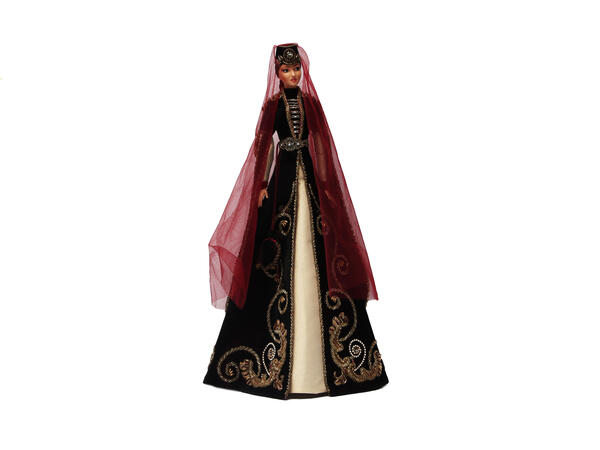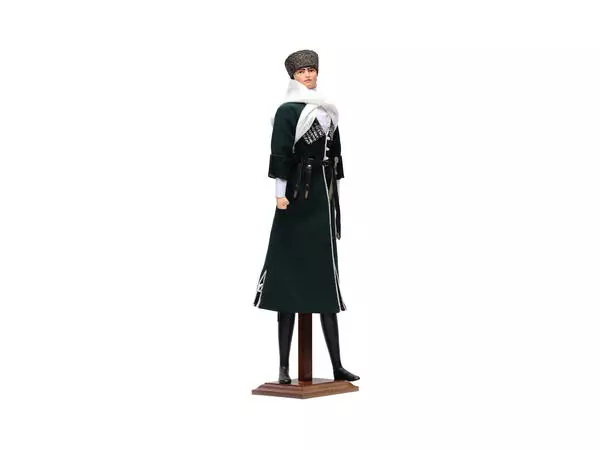Zina Inarkieva’s Fashion House has been making traditional Ingush clothes for more than 30 years. Its founder was an expert in costume history and a talented fashion designer. She passed away in 2014, but her daughters, Aina and Asya, continue her work.
The fashion house’s main principle has been to carefully revive the traditional national technique of sewing. Each costume is handcrafted by artists who use the highest quality materials. They draw inspiration from old archival photographs and archaeological artifacts found on the territory of Ingushetia.
The museum collection houses an ensemble of traditional Ingush dresses: a male and female costume. Aina Inarkieva created the doll in a traditional women’s dress.
The porcelain base was cast at a factory according to her sketches. She made the costume with embroidered patterns by hand. The craftswoman commissioned the silver jewelry from jewelers in Dagestan. The belt and the fasteners on the breastplate are made to meet all proportions: they duplicate the original old items.
This doll is dressed in the most important outfit for an Ingush woman — the ‘chokha’ or ‘chukha’. This dress was worn for special occasions. Brides wore it to their weddings, so they tried to make chokhas in the best fabric: velvet, brocade, silk.
They would make the dress with a long ankle-length skirt. The chokha could be fastened with 2-3 hooks on the front at the waist. The V-neck remained open, so that underneath it one could see an underdress or a breastplate with clasps ‘dato’. They would wear over the chokha a belt made of bronze and silver plates decorated with engravings, niello, gilding, and semiprecious stones.
The collar, skirt, front flaps, and sleeves of the dress were usually decorated with ribbon, lace, or fur. Also, the Ingush often embroidered ornaments on the front flaps and shirt.
A special headpiece, ‘ega kiy’ or ‘kiy’, crowned the bride’s head. It was decorated with gold and silver patterns like the rest of the costumes. They would wear a see-through shawl or scarf (‘shovlakh’ or ‘gaza chiffon’) over the hat.
All these features can be seen in the doll’s dress from the museum collection.
The fashion house’s main principle has been to carefully revive the traditional national technique of sewing. Each costume is handcrafted by artists who use the highest quality materials. They draw inspiration from old archival photographs and archaeological artifacts found on the territory of Ingushetia.
The museum collection houses an ensemble of traditional Ingush dresses: a male and female costume. Aina Inarkieva created the doll in a traditional women’s dress.
The porcelain base was cast at a factory according to her sketches. She made the costume with embroidered patterns by hand. The craftswoman commissioned the silver jewelry from jewelers in Dagestan. The belt and the fasteners on the breastplate are made to meet all proportions: they duplicate the original old items.
This doll is dressed in the most important outfit for an Ingush woman — the ‘chokha’ or ‘chukha’. This dress was worn for special occasions. Brides wore it to their weddings, so they tried to make chokhas in the best fabric: velvet, brocade, silk.
They would make the dress with a long ankle-length skirt. The chokha could be fastened with 2-3 hooks on the front at the waist. The V-neck remained open, so that underneath it one could see an underdress or a breastplate with clasps ‘dato’. They would wear over the chokha a belt made of bronze and silver plates decorated with engravings, niello, gilding, and semiprecious stones.
The collar, skirt, front flaps, and sleeves of the dress were usually decorated with ribbon, lace, or fur. Also, the Ingush often embroidered ornaments on the front flaps and shirt.
A special headpiece, ‘ega kiy’ or ‘kiy’, crowned the bride’s head. It was decorated with gold and silver patterns like the rest of the costumes. They would wear a see-through shawl or scarf (‘shovlakh’ or ‘gaza chiffon’) over the hat.
All these features can be seen in the doll’s dress from the museum collection.




